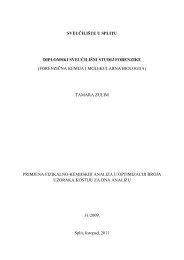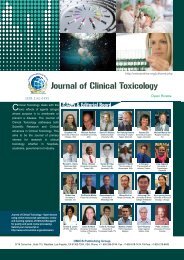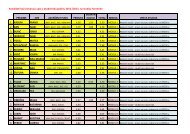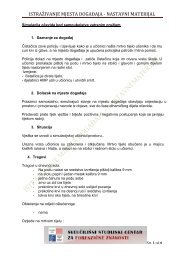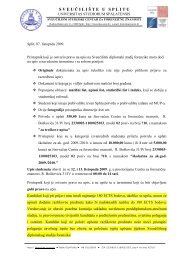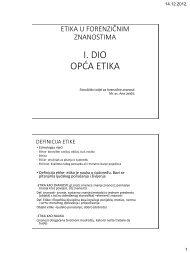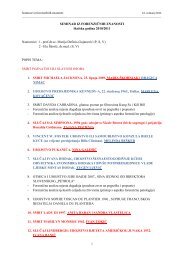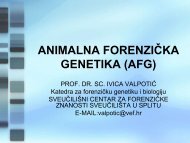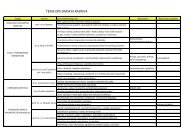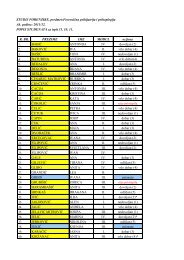The Individualization Fallacy in Forensic Science Evidence
The Individualization Fallacy in Forensic Science Evidence
The Individualization Fallacy in Forensic Science Evidence
You also want an ePaper? Increase the reach of your titles
YUMPU automatically turns print PDFs into web optimized ePapers that Google loves.
2008] FORENSIC EVIDENCE 211writ<strong>in</strong>g—favored dist<strong>in</strong>guish<strong>in</strong>g each writer from the others <strong>in</strong> thesample, the analysis fell short of its goal. 65 Even had the studysucceeded with<strong>in</strong> its own sample, it would not have answered thecrucial question whether every writer <strong>in</strong> the population is dist<strong>in</strong>ctfrom every other writer. Indeed, this study has been critiqued <strong>in</strong> somedetail. 66<strong>The</strong> claim of unique <strong>in</strong>dividuality cannot be proven withsamples, especially samples that are a t<strong>in</strong>y proportion of the relevantpopulation. As Bald<strong>in</strong>g commented: “It is impossible to prove anyhuman characteristic to be dist<strong>in</strong>ct <strong>in</strong> each <strong>in</strong>dividual withoutcheck<strong>in</strong>g every <strong>in</strong>dividual, which has not been done.” 67 Anyth<strong>in</strong>g lessresults <strong>in</strong> probability statements rather than conclusions of absolutespecificity and absolute identification.With no coherent theory to support the <strong>in</strong>dividualizationhypothesis and few studies that attempt to test the hypothesis,proponents have looked for other evidence that arguably supports aclaim of discernible uniqueness. 68 Some have seized on studies f<strong>in</strong>d<strong>in</strong>gthat monozygotic tw<strong>in</strong>s had discernibly different f<strong>in</strong>gerpr<strong>in</strong>ts. 69 Ifidentical tw<strong>in</strong>s do not have identical f<strong>in</strong>gerpr<strong>in</strong>ts, proceeds the logic,then surely everyone else has dist<strong>in</strong>guishable pr<strong>in</strong>ts. Thoughappeal<strong>in</strong>g at first, reflection suggests that the uniqueness hypothesiswould have found greater support if identical tw<strong>in</strong>s did have identicalf<strong>in</strong>gerpr<strong>in</strong>ts. If that were true, one could argue that if the phenotype off<strong>in</strong>gerpr<strong>in</strong>ts is isomorphic with the genotype, then whatever diversityexists <strong>in</strong> f<strong>in</strong>gerpr<strong>in</strong>t genotypes will be reflected <strong>in</strong> f<strong>in</strong>gerpr<strong>in</strong>t65. See id. at 871.66. Michael J. Saks, Commentary, Individuality of Handwrit<strong>in</strong>g, 48 J. FORENSIC SCI. 916,916-17 (2003). <strong>The</strong> critique po<strong>in</strong>ted out that, <strong>in</strong> fact, Srihari et al. had not found that each writercould be dist<strong>in</strong>guished with certa<strong>in</strong>ty from every other writer <strong>in</strong> their sample, even though thedesign of the study made the likelihood of f<strong>in</strong>d<strong>in</strong>g such dist<strong>in</strong>ctions unusually large, given: (1)the design of the sample (aim<strong>in</strong>g to obta<strong>in</strong> a representation of writers spread across the UnitedStates, rather than from homogeneous writ<strong>in</strong>g communities); (2) the size of the <strong>in</strong>ter-writersample (much too small for the research question); (3) the size of the writ<strong>in</strong>g sample (far morewords and forms and variations than encountered <strong>in</strong> virtually any forensic sett<strong>in</strong>g); (4) the size ofthe <strong>in</strong>tra-writer sample (too small to capture the variation present with<strong>in</strong> writers); and (5)reliance on cursive writ<strong>in</strong>g (so the study is irrelevant to many forensic <strong>in</strong>stances of smallamounts of hand pr<strong>in</strong>t<strong>in</strong>g or numbers). Moreover, the study <strong>in</strong>volved no human exam<strong>in</strong>ers, onlycomputer-based pattern recognition. Id. So whatever the study found, it could not tell us howwell or poorly humans could dist<strong>in</strong>guish one writer from another. (<strong>The</strong> authors assumed thathumans could do better than the computer, but that rema<strong>in</strong>s an untested empirical question.) Id.at 917.67. BALDING, supra note 16, at 54.68. <strong>The</strong> reader is rem<strong>in</strong>ded that the phrase “discernible uniqueness” is merely a shorthandway to describe the crim<strong>in</strong>alists’ presumption that conclusions about object uniqueness are notonly theoretically possible but atta<strong>in</strong>able <strong>in</strong> practice. See supra text accompany<strong>in</strong>g note 37.69. E.g., United States v. Mitchell, 365 F.3d 215, 223, 236 (3d Cir. 2004).




